A distortion pedal is one of the first stompboxes a bass player should purchase. It’s an easy way to increase your sonic versatility and to add oomph and aggression to your tone, often with dramatic results.
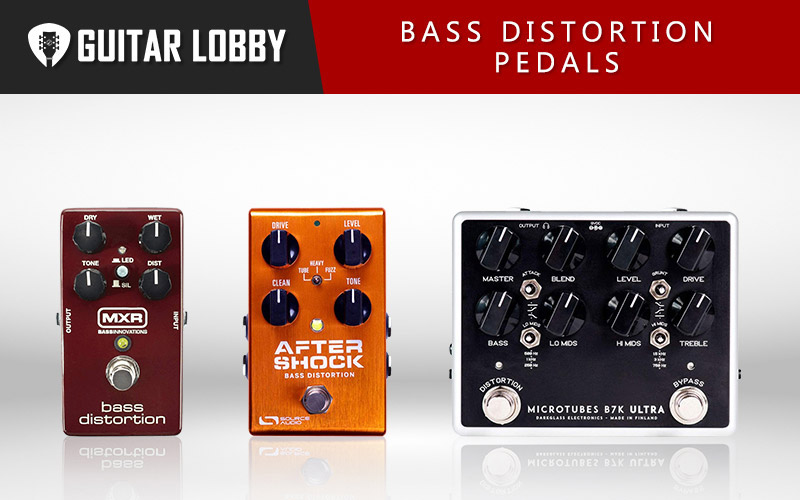
So, you’ve been thinking about adding a little more dirt to your bass tone or wondering about what distortion pedal to get and ended up scratching your head, since they are truly the most abundant pedal type in the world, this article will definitely help you out.
I’ve rounded up all the bass distortion pedals I could find, picked the best ones, and reviewed them to make it easier for you to choose a good one that fits your needs and wants.
I’ll start this review by jumping into reviews on the best bass distortion pedals at different price points, but if you want to learn more about them before reading reviews, check out our distortion pedal buying guide at the bottom of the page here.
| Name of Product | Image of Product | Description | Price Range | Full Review |
|---|---|---|---|---|
| 1. Darkglass Microtubes B7K Ultra V2 (Best Overall) | 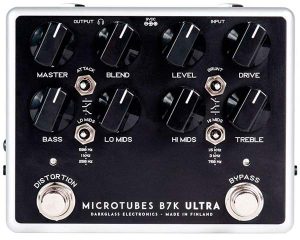 | Type: Analog Power: 9V 120mA PSU only | $430 | Read Full Review Below |
| 2. Source Audio Aftershock (Best Value) | 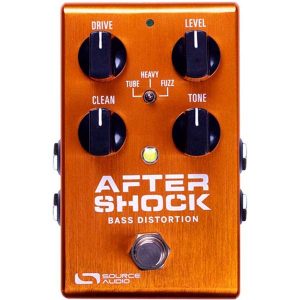 | Type: Digital Power: 9V 180mA PSU only | $150 | Read Full Review Below |
| 3. Behringer Bass Overdrive BOD400 (Best Cheap) | 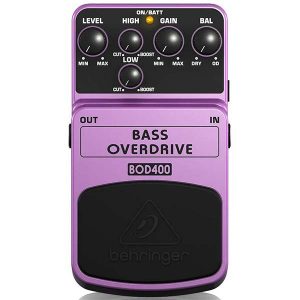 | Type: Analog Power: 9V PSU or 9V block battery | $55 | Read Full Review Below |
| 4. MXR M85 Bass Distortion (Editor’s Choice) | 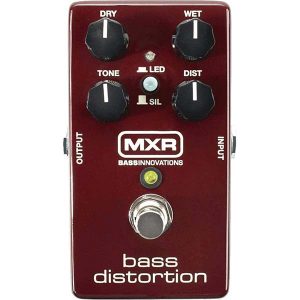 | Type: Analog Power: 9V PSU or 9V block battery | $140 | Read Full Review Below |
| 5. Aguilar AGRO Bass Overdrive | 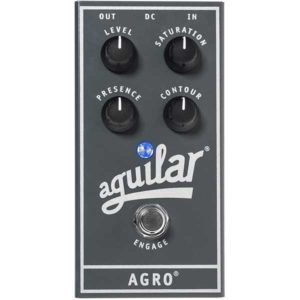 | Type: Analog Power: 9V PSU or 9V block battery | $190 | Read Full Review Below |
| 6. Electro-Harmonix XO Bass Blogger Distortion | 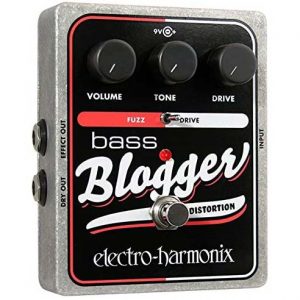 | Type: Analog Power: 9V 25mA PSU or 9V block battery | $90 | Read Full Review Below |
| 7. Ampeg Scrambler Bass Overdrive | 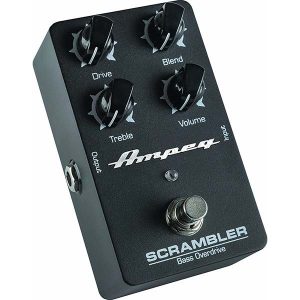 | Type: Analog Power: 9V PSU or 9V block battery | $130 | Read Full Review Below |
| 8. Electro-Harmonix Deluxe Bass Big Muff Pi | 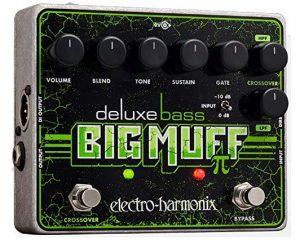 | Type: Analog Power: 9V PSU or 9V block battery | $160 | Read Full Review Below |
| 9. MXR M89 Bass Overdrive | 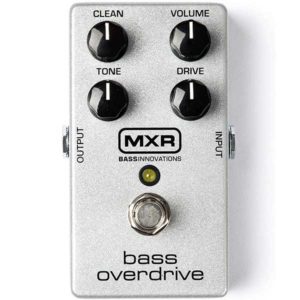 | Type: Analog Power: 9V PSU or 9V block battery | $130 | Read Full Review Below |
| 10. Darkglass Alpha Omicron Overdrive | 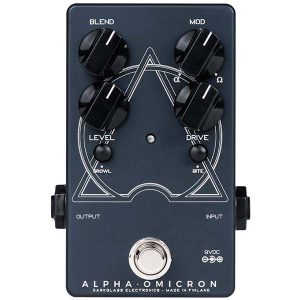 | Type: Analog Power: 9V 20mA PSU only | $200 | Read Full Review Below |
Here Are the Best Bass Distortion Pedals
1. Darkglass Microtubes B7K Ultra V2 (Best Overall)
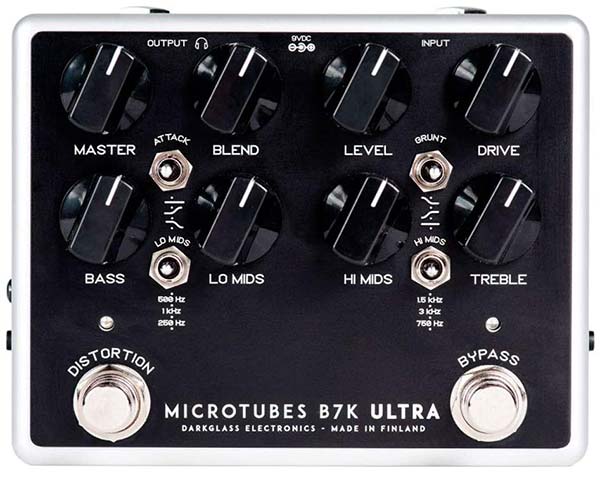
| Estimated Price | $430 |
| Type | Analog bass distortion pedal and preamp with digital cabinet simulation |
| I/O | 1x¼” input, 1x¼” output, D.I. XLR out, 3.5mm headphone input, 3.5mm aux in, micro USB |
| Power Supply | 9V DC 120mA PSU only |
My Review: Finnish bass gear maker Darkglass has made a reputation for itself offering premium distortion pedals designed from the ground up for us bass players. The B7K ultra is their flagship distortion pedal and it is feature-packed. You get two pedals in one: you have a clean preamp and EQ section and a versatile and wide-ranging overdrive/distortion section, with individual footswitches. The control layout is a little cramped with 8 control knobs and four 3-way dip switches, but you’ll quickly get used to it as it is quite intuitive.
When you engage de preamp section by hitting the bypass footswitch, you get access to the master volume control that lets you set the output level of the pedal and the active EQ – Bass (+/-12dB@100Hz), Lo Mids (+/-12dB@250/500/1kHz), Hi Mids (+/-12dB@750/1.5/3kHz), Treble (+/-12dB@5kHz) plus the two dip switches that let you set the center frequencies of the lo and hi mids. Engaging the Distortion footswitch adds the Drive, Level, and Blend knobs into the mix as well as the two remaining 3-way dip switches for Attack and Grunt. The Attack switch determines how the high-end of your distorted signal behaves, either flat, boost, or cut. The Grunt switch does the same thing as the Attack switch but for the low-end.
Drive sets the amount of overdrive/distortion, Level lets you adjust the volume of the distortion effect and Blend lets you mix your distorted signal with your dry signal. The B7K Ultra offers a very wide range of distortion sounds, from slightly overdriven to almost fuzz-like levels of distortion and sustain. And they all sound excellent while on the more aggressive side. Slight overdrive might not be as smooth as with a dedicated bass overdrive pedal, but this one is 95 percent there. This pedal’s strong points are definitely the heavily distorted sounds which sound fantastic with lots of punch and definition. The ability to blend in your dry signal gives you even more tonal options. The D.I. is clean and transparent (with a ground lift switch on the side), and the cabinet simulator which you can add to the DI signal through the use of a switch on the side of the pedal, is a welcome addition. There’s a 3.5mm headphone jack input and a 3.5mm aux in, letting you jam to your favorite tracks or practice freely without waking the neighbors.
Key Specs: The B7K Ultra is an analog distortion pedal with digital cabinet simulation. It pairs a versatile preamp/active EQ section with a powerful distortion section. The EQ lets you shape your tone as you wish: +/-12dB cut or boost for Bass, Lo Mids, Hi Mids, and Treble, the Lo Mids, and Hi Mids, each has three selectable center frequencies. The two footswitches let you engage the preamp and distortion sections separately. The DI XLR balanced out enables you to send your signal straight into the console or PA system. The 3.5mm headphone in and 3.5mm aux-in lets you practice in silence. It draws 120mA@9V DC from a PSU only.
Target Customer: This is one of the most versatile pedals on this list, so who’s it for? This pedal is for anyone and everyone looking for a great distortion pedal! You can use it as a transparent preamp to shape your clean tone, and you can get wall-shattering distortion from it. It has a lot of knobs, but the layout is intuitive and straightforward, taking almost no time to master it. The B7K Ultra will be a good fit for any modern music genre that requires great distortion.
Bottom Line: The B7K Ultra is the swiss army knife of distortion pedals. You get a preamp/EQ, you get a wide range of distortion sounds, you get a DI, and you get a practice tool. It may seem a bit on the expensive side, but it is fairly priced for the pile of features it brings to the table.
2. Source Audio Aftershock (Best Value)
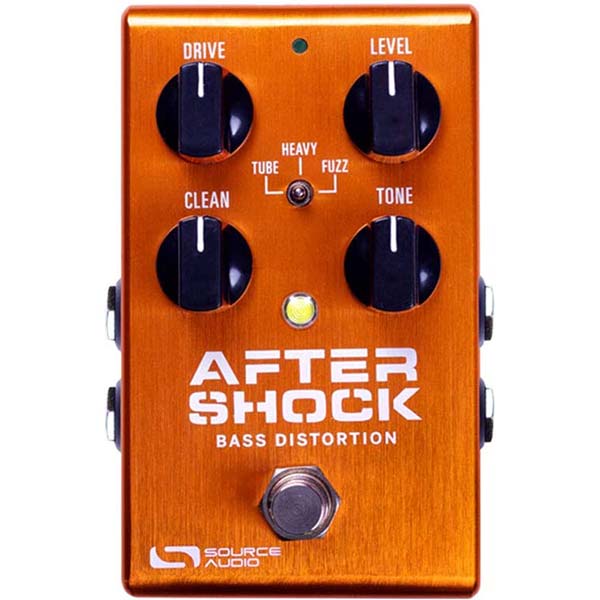
| Estimated Price | $150 |
| Type | Digital bass distortion pedal |
| I/O | 2x¼” input, 2x¼” output, 3.5mm in for external control, USB port |
| Power Supply | 9V 180mA PSU only |
My Review: Source Audio are known for their excellent digital pedals and stompboxes, and the Aftershock makes no exception. This is a digital bass distortion pedal with great versatility and a lot of hidden features. At first glance, the Aftershock seems like a standard distortion pedal, with 4 control knobs marked Drive, Level, Tone, and Clean, a single 3-way dip switch in the middle, and a standard footswitch. The Drive knob sets the amount of distortion, Level adjusts the overall output level of the pedal, Clean determines the amount of dry signal you want to add to the output, and Tone adjusts the tone of the distortion effect, turn clockwise for brighter sounds, anticlockwise for darker sounds.
The dip switch lets you select one of 3 preset distortion sounds: Tube, Heavy, and Fuzz. The Tube setting is an overdrive simulation and it sounds smooth and creamy, Heavy gives you access to heavy distortion sounds, and Fuzz gives you all the woolly madness you could ask for from a fuzz effect. If this was all there was to the Aftershock, it would already be an awesome distortion pedal. But there’s more. On closer inspection, you’ll notice it has 2x ¼” inputs and 2x ¼” outputs. These give you a lot of routing options: from running one or two instruments into two separate rigs with different distortion circuits for each to using the additional in/out as an external effects loop. Then you’ll notice a USB port, and this makes the Aftershock a whopper.
If you connect it to your PC or Mac you get access to a whole suite of additional parameters. Firstly you get to edit the ”Tube, Heavy, Fuzz” settings, meaning that you can select any one of the tens of preset distortion types and save them to one of the three selector switch positions. You also get access to the 2 separate distortion engines, parametric EQ, Noise gate, filters, routing options, and external control, to name just a few.
Key Specs: The Aftershock is a digital distortion pedal made for bass guitar. It features true stereo operation with 2 inputs and 2 outputs. It has a standard control layout for a distortion pedal, with Drive, Level, Tone, and Clean knobs and a 3-way switch to select the desired distortion mode: Tube, Heavy, and Fuzz. The USB port found on the front side of the pedal gives you access to a plethora of customization options, letting you tailor the sound to your specific needs. The 3.5mm control input port lets you connect to external control devices such as expression pedals or Source Audio’s Hot Hand Motion Controller. It is housed in a sturdy and pedalboard-friendly enclosure. The Aftershock is powered with a 9V PSU only and draws 180mA.
Target Customer: The Aftershock is a very versatile distortion pedal, and with the added tweakability when connected to a PC or Mac, your options are almost limitless. If you are new to distortion pedals and don’t want or need the in-depth features, the 3 basic sounds it offers out of the box for Overdrive, Distortion, and Fuzz all sound excellent – so you will get your worth anyway.
Bottom Line: The Aftershock is one of the most versatile pedals on the market. It offers 3 great sounding presets straight out of the box, but to get everything out of it you need to spend a little time tweaking the presets to your liking. At this price, you get dozens of pedals for the price of one. Overall, I would say that you really can’t go wrong with this pedal. In my opinion, it’s the best bass distortion pedal for the money.
Popular Related Article: Our Favorite Bass Compressor Pedals (All Price Ranges)
3. Behringer Bass Overdrive BOD400 (Best Cheap)
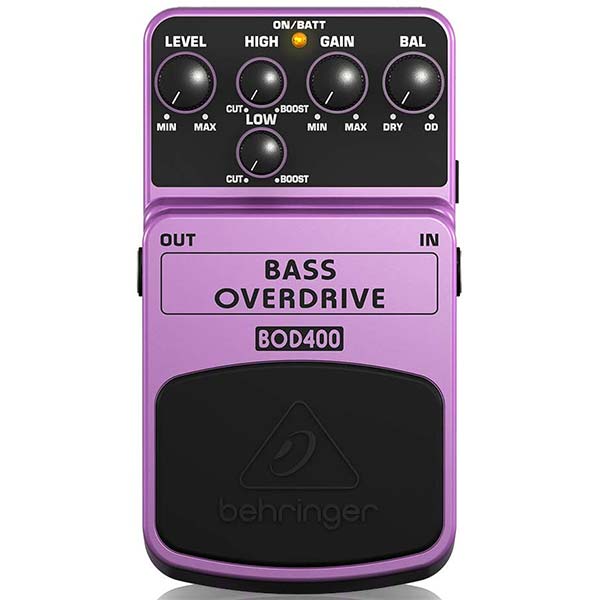
| Estimated Price | $55 |
| Type | Analog bass overdrive pedal |
| I/O | 1x¼” input, 1x¼” output |
| Power Supply | 9V PSU or 9V block battery |
My Review: By now everyone knows what Behringer pedals are about: colorful plastic enclosures, good clones of legendary effects, and very low prices. The BOD400 is a clone of the Boss ODB-3 bass overdrive pedal, and in an A/B test, you wouldn’t know the difference. The purple plastic enclosure features a simple control layout with Level setting the output volume, Gain determines the amount of overdrive/distortion, Balance blends your dry signal with the processed ones, and a 2-band boost/cut EQ lets you shape your tone to your liking.
The range of good sounds you get is surprising, from a light, creamy overdrive to heavy distortion, the BOD 400 does it all. The noise level is also unexpectedly low. At some extreme settings, it can get a little synthetic when compared to other overdrive pedals, but it still sounds good and the tones are all usable in the right situation.
Key Specs: The BOD400 is housed in a purple, hard plastic enclosure. It features a 5-knob control layout with Gain, Level, Balance, and a 2-band boost/cut EQ with High and Low knobs. You can power it with a 9V standard PSU or 9V block battery. This is a buffered bypass pedal, but it’s a good buffer, so no worries about loss of tone. The only concern might be with the enclosure, but the plastic is actually very durable and they rarely break.
Target Customer: If you’re in need of an overdrive pedal for that one riff in the song, if you’re just now getting into pedals and want to try them all out, or if you’re low on cash but want a good overdrive pedal that does its job as it should, then the BOD400 could be the pedal for you.
Bottom Line: The BOD400 is an analog bass overdrive pedal that has made a name for itself in the bass player community, due to its very low price and very good overdrive sounds.
4. MXR M85 Bass Distortion (Editor’s Choice)
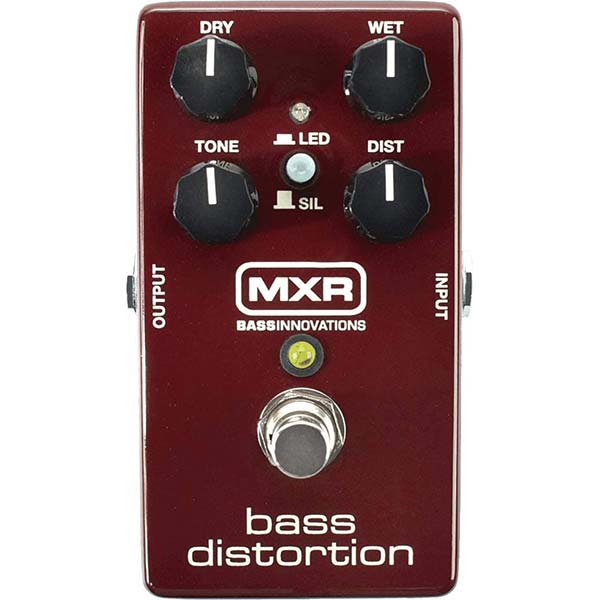
| Estimated Price | $140 |
| Type | Analog bass distortion pedal |
| I/O | 1x¼” input, 1x¼” output |
| Power Supply | 9V PSU or 9V block battery |
My Review: This is a very cool pedal from MXR. They’ve partnered with Fuzzrocious Pedals founder Ryan Ratajski and came up with the M85 bass distortion pedal. What makes this pedal special is that you can switch between two distortion circuits, the Sil setting uses silicon diodes to clip your signal, while LED uses Light Emitting Diodes to achieve the distortion effect. The M85 has a simple 4-knob control layout, Distortion sets the amount of distortion applied to your signal, Dry determines the volume of your dry tone that gets added to the output, Wet controls the volume of the distorted signal that gets added to the output, Tone is a high-frequency roll-off that only affects the distorted signal.
The pedal gets a wide range of distortion tones right. The Sil setting has a more aggressive sound with lots of harmonics and more compression while the LED setting sounds open and warm, responding better to playing dynamics. The M85 is quite versatile as a distortion pedal, letting you easily dial in vintage, lo-fi, fuzz-like bass tones as well as tight and punchy metal bass lines.
Key Specs: The M85 is an all-analog bass distortion pedal with two-tone generation circuits, selectable with a switch on the faceplate. The control layout is simple and straightforward, Distortion, Tone(affects only the distorted signal), and separate Wet and Dry controls to dial in your preferred mix of the clean and distorted signal. There’s an internal trim pot to adjust the gain of the LED clipping circuit, it also has a true bypass, so none of your tone is lost when the pedal is off. It draws 11mA@9V from a PSU or 9V battery.
Target Customer: The M85 is very versatile due to its two separate distortion circuits, but it is a rock pedal through and through. It’s straightforward to use, and it sounds great in a vintage rock setting as well as in a metal band. If you’re looking for an analog bass distortion pedal, that’s built in the USA and doesn’t cost a lot for what it offers, take a peek at the M85, you won’t regret it.
Bottom Line: You get two different distortion sounds in one ruggedly built pedal, that comes in a pedalboard-friendly format, and doesn’t break the bank. If you’re looking for the best cheap bass distortion pedal, look no further!
Popular Related Article: 21 Bass Guitars You Need to Know About
5. Aguilar AGRO Bass Overdrive
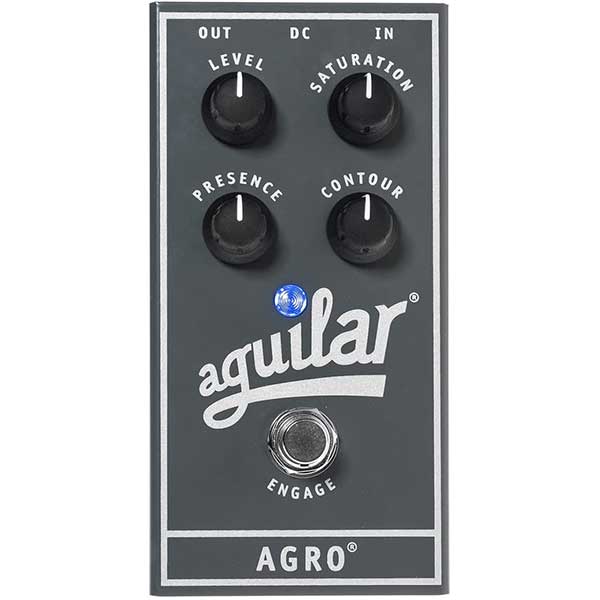
| Estimated Price | $190 |
| Type | Analog bass overdrive pedal |
| I/O | 1x¼” input, 1x¼” output |
| Power Supply | 9V PSU or 9V block battery |
My Review: Aguilar is one of the most respected brands of bass gear around, and when they bring out a pedal, it gets noticed. And the Agro got noticed. It is an overdrive/distortion pedal with a simple 4-knob layout: Level adjusts your output volume, Saturation sets the amount of distortion, Contour controls a broad mid-scoop with its center @900Hz, and Presence boosts or cuts treble above 4kHz by +6/-20dB. It is built like a tank and feels much heavier than other pedals.
The Agro pedal is based on the saturation channel of the AG500 bass head so you can anticipate what it sounds like: natural, warm, rich, and dynamically responsive. The Saturation knob controls a very wide range of overdrive sounds, up to quite heavily distorted tones. But the heart of the Agro lies with vintage overdriven bass – and it does it very well. Presence and Contour have well-chosen frequencies and are largely responsible for the Agro’s versatility. The surprising thing coming from a pedal without a blend knob is that you don’t lose your low end when you turn it on, the sound is full, musical, and never thin. The noise floor of the Agro is lower than with most other pedals.
Key Specs: The Agro is an analog bass overdrive/distortion pedal, built around the saturation channel of the AG500 head. It’s built into a sturdy metal enclosure and has a 4-knob control layout: Level, Saturation, Contour, and Presence. The Agro has a true bypass circuit and can run on a 9V battery or 9V PSU.
Target Customer: This is a pedal for bass players looking for great vintage sounds from a high-quality pedal. It’s easy to set up and has a nice variety of tones on offer including more heavily compressed sounds you would expect from a “distortion” pedal and not an overdrive. It’s not a cheap pedal but it’s built in the USA to Aguilar’s high standards and has very good sounds on offer.
Bottom Line: Aguilar’s Agro is a high-quality overdrive/distortion pedal, with a good tonal range and great sounds. It’s not cheap, but if you are looking for a good overdrive – it’s worth it.
6. Electro-Harmonix XO Bass Blogger Distortion
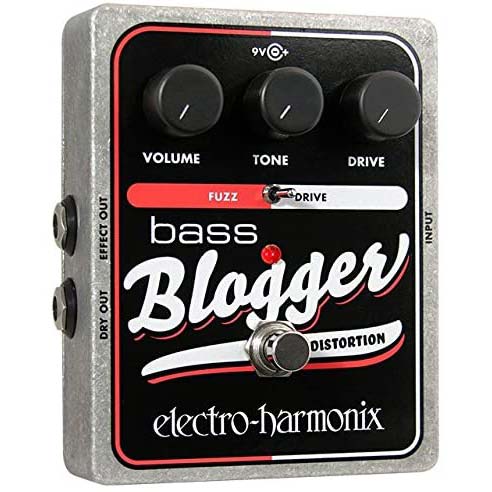
| Estimated Price | $90 |
| Type | Analog bass distortion/fuzz pedal |
| I/O | 1x¼” input, 1x¼” output 1x¼” direct output |
| Power Supply | 9V 25mA PSU or 9V block battery |
My Review: Electro-Harmonix makes a lot of good pedals, and the Bass Blogger is certainly one of them. It’s an analog dual-mode distortion/fuzz pedal designed for bass. It features a 3-knob layout: Drive sets the amount of distortion or fuzz, Tone controls the high-end content of the distorted signal, Volume sets the output volume but it is inactive while the pedal is in Drive mode. The 2-way switch lets you select the distortion circuit: Fuzz or Drive.
The Fuzz mode gives you access to a wide range of fuzz sounds, from the smooth and musical up to heavily sustained, compressed, woolly fuzz insanity with lots of low-end. In Drive mode, you get warm overdrive sounds, but when cranking up the Drive knob you get into real distortion territory. Drive mode also has a more percussive and punchy midrange, cutting easier through the mix. On the left side of the pedal, you’ll see two outputs, the first one is the output for your distorted signal, the second one is a dry out, meaning that you can mix in some of your dry, unaffected signal later in the chain.
Key Specs: The Bass Blogger is a good quality analog fuzz/overdrive pedal built into a rugged aluminum enclosure. It has a simple 3-knob control layout (Drive, Tone, Volume), and a 2-way dip switch to select one of the two distortion circuits: Fuzz or Drive. It has a ¼” direct out which gives you some nice routing options. There’s also a true bypass circuit, so you can play on if it loses power. It draws 25mA from a 9V PSU or 9V battery.
Target Customer: The Bass Blogger is not your standard distortion pedal, with its 2 separate distortion circuits. It’s very easy to set up and offers a wide range of good sounding distortion tones. If you want a good quality fuzz/overdrive pedal and don’t want to spend a ton of cash, get the Bass Blogger and you won’t be disappointed.
Bottom Line: This is a good quality pedal, from a reputed pedal maker, and you get 2 pedals in one: a fuzz and an overdrive/distortion at the dip of a switch. The sounds it has on offer are varied and the price doesn’t reflect this pedal’s numerous qualities.
Popular Related Article: 12 Bass Guitars that Are Great for Metal
7. Ampeg Scrambler Bass Overdrive
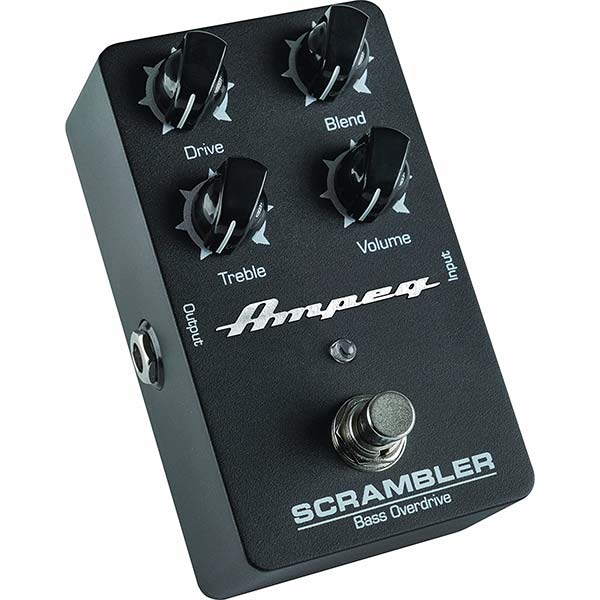
| Estimated Price | $130 |
| Type | Analog bass overdrive pedal |
| I/O | 1x¼” input, 1x¼” output |
| Power Supply | 9V PSU or 9V block battery |
My Review: The Scrambler is a newer bass overdrive pedal in Ampeg’s pedal lineup. It took some time for this circuit to reach a pedal format, migrating from the BA-line of bass combos, to the SCR-DI preamp/DI and finally to this pedalboard-friendly, black, metal enclosure. The Scrambler has an intuitive 4 knob layout: Volume sets the output level, Drive sets the amount of distortion, Blend lets you mix in your dry signal, and Treble boosts or cuts high-end at 4kH by +17/-14dB.
The sounds it produces are Ampeg typical, from a mild overdriven tube-like tone to compressed, harmonically rich distortion – the Scrambler does it all. The noise floor is quite low for most of the drive range, it gets noticeable only at extreme settings.
Key Specs: The Scrambler is a well-built, analog overdrive pedal with a 4 knob control layout: Volume, Drive, Blend, Treble (boost/cut +17/-14@4kH). It has a true bypass circuit and it draws 20mA from a 9V PSU or 9V battery.
Target Customer: This is a straightforward, no-frills bass overdrive pedal. It’s very easy to set up and use without reading the manual. It has a great build quality and the range of distortion sounds it offers fits in anywhere from funk to metal.
Bottom Line: The Scrambler is a great addition to any pedalboard, it’s compact, it’s built like a tank and its range of sounds could be fit for anyone from noob to pro. You get a good little overdrive for a fair price.
8. Electro-Harmonix Deluxe Bass Big Muff Pi
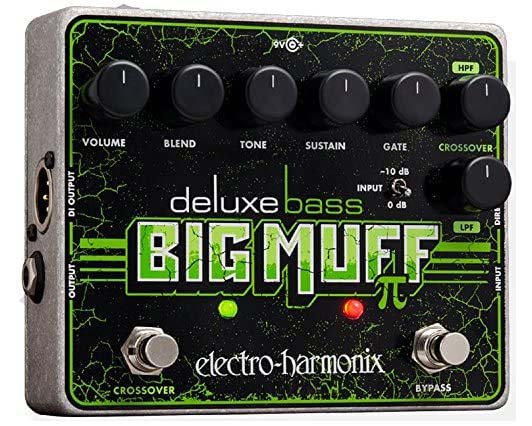
| Estimated Price | $160 |
| Type | Analog bass fuzz pedal |
| I/O | 1x¼” input, 1x¼” output |
| Power Supply | 9V PSU or 9V block battery |
My Review: The Big Muff Pi from EHX is a legendary fuzz pedal among guitar and bass players alike. Through its iterations, there have been a few Big Muff Pi’s geared towards the bass player but none of them had this level of control and sophistication. It features 7 knobs, 2 footswitches, and a dip switch. The Volume knob sets the output volume of the pedal, Blend lets you dial in your desired ratio of the wet and dry signals, Tone cuts or boosts high mids and treble, Sustain sets the amount of fuzz you want to add to your signal, Gate controls the sensitivity of the onboard noise gate, HPF sets the range of the high pass filter, LPF sets the range of the low pass filter, and the toggle switch lets you select a -10dB cut to accommodate basses with hotter inputs.
The Bypass footswitch turns the pedal on and off, while the crossover footswitch activates the selected settings for the high and low pass filters. All this tweaking potential makes the Deluxe BBMP one of the most versatile distortion pedals around. The Sustain, Tone and Blend knobs work in unison to deliver a wide range of sounds, adding just a touch of Sustain and more dry than wet signal yields smooth, overdriven bass tones; turning up the Sustain gets you fully saturated, harmonically rich, buzzsaw fuzz tones. The noise gate on this pedal is a godsend, as Big Muffs get notoriously noisy, and it works exactly how it should. By tweaking the two filters you get even more tone shaping options and you get two different distortion sounds at the press of a footswitch.
Key Specs: The Deluxe Bass Big Muff Pi is the ultimate form of the Big Muff Bass fuzz. It is built in a double-sized, cast aluminum enclosure, and has 7 control knobs (Volume, Blend, Tone, Sustain, Gate, HPF, LPF), a -10dB switch, and 2 footswitches (Bypass and Crossover). It gives you a lot of routing options, with its ¼” Direct Out that lets you send your dry buffered signal to a second amp or to another effects chain, and it also has an XLR D.I. output that allows you to send your wet signal directly into a mixing console or recording equipment. It can run on a 9V battery or a standard 9V PSU.
Target Customer: The Deluxe BBMP is geared at the lovers of Fuzz. It is a very versatile and good sounding pedal, but its complex control layout might scare away new bass players (it shouldn’t). It requires you to spend a few minutes with it to figure out what everything does, but once that’s done, you’re off reaping the tonal rewards. For what this fully packed pedal offers, the price tag it comes with seems too low. If you like to be in total control of your fuzz pedal, this might be it.
Bottom Line: This pedal is feature-packed, and it is the result of years and years of bass player feedback. This is the ultimate fuzz pedal at a very reasonable price.
Popular Related Article: Our Recommended Bass Pickups at All Price Ranges
9. MXR M89 Bass Overdrive

| Estimated Price | $130 |
| Type | Analog bass overdrive pedal |
| I/O | 1x¼” input, 1x¼” output |
| Power Supply | 9V PSU or 9V block battery |
My Review: The M89 is an all-analog overdrive from the pedal gurus at MXR. It comes in an MXR standard cast aluminum enclosure and features a simple 4-knob layout: Volume sets the output level of the pedal, Drive determines the amount of overdrive, Tone lets you cut or boost the treble, and Clean lets you mix in an EQed dry signal with the overdriven one. The build quality is excellent and you get a wide range of warm, tube-like overdrive sounds. When you turn up the drive knob you get a few nice, hard compression, distortion sounds. The noise levels are very good even at higher drive settings.
Key Specs: The M89 is a high-quality bass overdrive pedal with a 4-knob control layout (Volume, Drive, Tone, and Clean). Clean blends in a preset-EQ clean signal to your overdriven signal. It comes in MXR’s standard sized, metal enclosure with a really small footprint. The M89 features a true bypass circuit and can be powered either with a standard 9V PSU or a 9V block battery.
Target Customer: This is a workhorse bass overdrive. It delivers overtone rich, creamy, tube-like overdrive in a pedalboard-friendly package. The simple control layout and good design let you quickly dial in the perfect overdrive sounds. It also gives you harder distortion sounds with higher Drive settings.
Bottom Line: The M89 is a high-quality overdrive pedal, well suited for any style of music and any level of player. It’s a great pedal if you want some crunch in your bass tone, and its price is fair.
10. Darkglass Alpha Omicron Overdrive
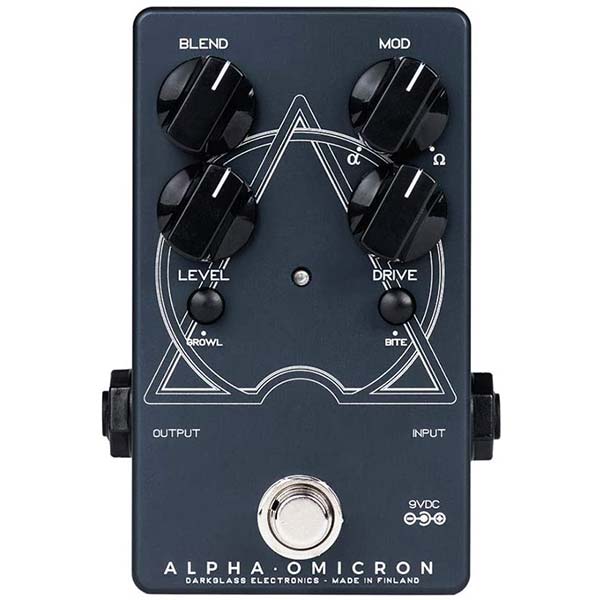
| Estimated Price | $200 |
| Type | Analog bass overdrive pedal |
| I/O | 1x¼” input, 1x¼” output |
| Power Supply | 9V 20mA PSU only |
My Review: The Alpha Omicron is an all-analog overdrive pedal from Darkglass Electronics in Finland. They are already well established among bass players of the harder rock genres for their high-quality distortion pedals and the Alpha Omicron is a smaller form factor sibling of the very popular Alpha Omega but without the latter’s preamp section. With the Omicron you get all the growl and bite you could wish for. It has a 4-knob layout and 2 switches. Blend lets you mix your clean signal with the distorted one, Drive sets the amount of distortion, Level sets the output volume, and Mod selects or mixes the two distortion circuits of this pedal: Alpha and Omega.
Alpha has a tight and punchy sound with lots of compression, while Omega has a more aggressive quality with more treble content. The Bite switch boosts high mids @2.8kHz for increased presence and definition, and Growl boosts your lows for a thicker tone. The variety of tones you get from the Omicron is surprising, the two distortion circuits make this a very versatile pedal. You can get soft overdriven tones from it, but it clearly performs better with the Drive knob past 9 o’clock.
Key Specs: The Alpha Omicron is a high-quality overdrive pedal with two separate blendable distortion circuits. The layout is simple and straightforward: control knobs for Blend, Drive, Level, and Mod (selects or blends the two distortion voices). The Bite and Growl switches boost high mids, and lows, respectively. The pedal is housed in a sturdy aluminum enclosure and comes with a true bypass circuit. The Omicron draws 20mA from a standard 9V PSU only, it doesn’t accept batteries.
Target Customer: This pedal was made to rock! – It’s rather on the pricey side but when you hear it, few pedals can match its aggressive sounds. The simple and intuitive controls let you dial in your preferred tone in a matter of seconds without having to read the manual.
Bottom Line: The Alpha Omicron is an extremely well-built bass overdrive pedal, with a range of sounds geared towards the heavier side of rock music. It delivers warm, harmonically rich tones as well as wall-shaking heavy distortion.
Choosing a Bass Distortion Pedal (Buying Guide)
This section is for those of you who want to learn more distortion pedals before reading reviews.
What is Distortion?
Distortion is a term that is thrown around a lot but not many understand what it really is or does except making you sound more awesome. Distortion occurs when the original waveform of the signal is altered. What is meant by “distortion” in a musical setting usually refers to one of the three main flavors it comes in: Overdrive, Distortion, and Fuzz. They are all technically distortion and they differ only in the way and the severity in which they alter your signal.
But Overdrive was the one that started it all.
Overdrive is what happens to your sound when you turn up the volume of your tube amp past its ability to reproduce faithfully – which is how electric blues guitar players in the 1950s started to get that warm and sweet “overdriven” sound (some got an overdriven sound by punching holes into their speakers, but don’t do that!).
What you hear is your signal being cut off at its highest and lowest frequencies. And in contrast to the distortion effect, this cutoff or clipping is soft, which means the transition between waveforms occurs more smoothly. An overdriven signal will compress your sound and increase your gain while adding sustain and harmonic overtones. What a bass overdrive pedal will try to do is to emulate an overdriven tube as closely as possible using MOSFET or JFET transistors to produce the soft clipping, but fine-tuned for bass frequencies.
You should get a smooth and warm crunch in your bass sound without loosing too much dynamic range or added noise.
Distortion: This is an effect that has defined metal. The distinction between heavier overdrive and softer distortion is often quite arbitrary and subjective, but what distortion does to your signal when compared to overdrive; it is just more: it clips and compresses your signal much harder (a more sudden transition from one wave to the next and), it reduces your dynamic range (no matter how soft you play, you’ll still get the same amount of distortion), you get even more harmonic overtone content and more sustain.
If you play chords on bass, you will notice how little tonal separation there is between individual notes. The sound is clipped, punchy, and. Bass distortion pedals use transistors to achieve the harder clipping of your signal.
Fuzz: Defined the 1960s rock sound. The fuzz pedal was the first “distortion” pedal to find general appeal. The Fuzz effect is achieved by using germanium or silicon transistors. Aficionados describe germanium-based pedals as sounding warm while silicon transistors offer a harsher, more compressed tone. A fuzz pedal will clip your signal very hard, so hard in fact that it almost turns into a square wave. It obliterates any hopes of dynamic range but gives sustain without end, huge amounts of saturation, and lots of harmonic overtones. The compression that occurs is much more pronounced than with distortion pedals.
What to look for in a good distortion pedal:
Build quality is an important factor when buying any piece of gear, but in a pedal, it’s especially important as it will inevitably get tread-on a lot. Luckily most worthwhile pedals are sturdy and well-built, with most having aluminum enclosures, and good quality foot switches and pots.
Good distortion pedals often have blend knobs to mix in some of your original, unaltered signal with the effected one, this helps with adding back some of the dynamic range you lose by distorting your signal.
Because Fuzz and Distortion cut so much out of your signal, some of the better thought out pedals have a way to add some of the lost low-end back to your signal with some form of EQ (Bass, mids, and treble controls are well appreciated).
Gain Control: you’ll find this knob on every distortion pedal out there, it determines the amount of distortion you’ll get. Sometimes it’s called saturation but the effect is the same.
Output Control: as your signal is distorted, your volume level will go up, so a form of output volume control is a good idea to manage the differences in volume.
Buffered bypass/True bypass: When you add pedals to your chain, some signal degradation is unavoidable, and the more pedals you have, the more degradation your signal will go through. True-bypass means that when you switch off your pedal or if it loses power for some reason, your signal will pass through the pedal as if it weren’t there. Some signal degradation does occur but it is virtually unnoticeable with fewer pedals.
Buffered bypass pedals are helpful when you are running your signal through a lot of pedals, each one in the chain leaving your signal slightly weaker and degraded. Buffered bypass boosts your signal strength slightly to make up for the natural degradation of the signal. With large pedalboards it is preferred for the first and last pedals in the chain to be buffered bypass pedals, the first one pushing your signal through the pedalboard chain while the last one pushes the signal through the last cable, ensuring that a strong signal reaches the amp.
Some pedals let you take your pick between true and buffered bypass.
Noise: As the distortion effects are achieved by increasing the gain of the signal, the noise floor also gets raised – some pedals get very high noise levels when cranked up. To reduce the noise levels, some pedals come with built-in noise gates – a very useful feature with heavy distortion and fuzz.
DI: Stands for Direct Injection, it is a premium feature and is therefore found on some of the pricier pedals out there. What a D.I. does? – it takes an unbalanced, high impedance signal like from your instrument and turns it into a balanced, low impedance signal. This means that you can send the signal directly to the console or into the P.A. and it prevents degradation when running the signal through long cables. It just gives you a lot more options when playing live or when recording in the studio.
Analog vs Digital: Purists will frown at a digital distortion pedal, but distortion emulation has come a long way since first arriving on the market. Digital distortion pedals have become indistinguishable from their analog brethren while offering much lower noise levels, on average more tone-shaping options, or cool features like letting choosing the type of waveform for your distortion sound.
How to Use Distortion Pedals
As with any effect, how you use it is entirely up to you, and depends on what sound you are aiming for, but there are some generally agreed guidelines. A distortion pedal is usually one of the first ones in the signal chain, be it overdrive, distortion, or fuzz. Distortion and bass go very well together because typically the low frequencies bass players deal with don’t have as much tone or character as instruments in the upper tonal ranges, so adding some distortion can add a lot of interest to the bass line.
If you are looking for a warm and organic tone that gives you just a little more grit without eliminating your dynamic range, then perhaps Overdrive is the distortion effect you are searching for. Overdriven bass can be heard in any type of music from early rock to funk and pop.
If you are looking for a more aggressive tone, that is quite compressed then maybe distortion is what you want. Heavily distorted bass can be heard on most metal records, but it is widely used in all genres from the more aggressive side of the musical spectrum.
If you want a heavily distorted tone, that sounds aggressive and is very harmonically saturated maybe you are looking for a fuzz pedal. They have been extensively used since the ‘60s in genres ranging from classic rock, garage, or stoner to alternative, pop, and EDM.
As there’s a relatively blurry line separating “distortion” pedals into Overdrive, Distortion, and Fuzz, sometimes effects units can overlap in their functionality.

My name is Chris and I’ve had a passion for music and guitars for as long as I can remember. I started this website with some of my friends who are musicians, music teachers, gear heads, and music enthusiasts so we could provide high-quality guitar and music-related content.
I’ve been playing guitar since I was 13 years old and am an avid collector. Amps, pedals, guitars, bass, drums, microphones, studio, and recording gear, I love it all.
I was born and raised in Western Pennsylvania. My background is in Electrical Engineering, earning a Bachelor’s degree from Youngstown State University. With my engineering experience, I’ve developed as a designer of guitar amplifiers and effects. A true passion of mine, I’ve designed, built, and repaired a wide range of guitar amps and electronics. Here at the Guitar Lobby, our aim is to share our passion for Music and gear with the rest of the music community.
